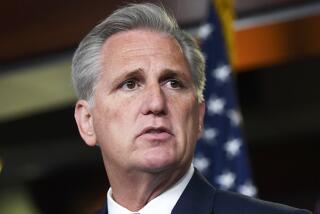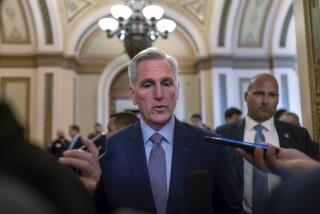Growing crisis drives urgency in planning
- Share via
WASHINGTON — The Obama administration is preparing a comprehensive strategy to address the escalating financial crisis, stem home foreclosures and jump-start the overall economy, signaling that the president hopes to deal with the problems systematically instead of case by case.
The plan probably will not be delivered for several weeks, Timothy Geithner, the nominee for Treasury secretary, said Wednesday.
“We’re at the beginning of this process of repairing the system, not close to the end of that process,” Geithner told the Senate Finance Committee. “And it is going to require much more substantial action on a very dramatic scale.”
But on the banking front, it remains to be seen how much time the administration has to come up with a plan.
For the last several weeks, Obama and his aides had hoped that the financial system, though seriously weakened, would remain stable enough to allow the administration to focus on repairing the broader economy, which would help lift the prospects of financial firms along with those of ordinary Americans.
But fear of a wider banking collapse has grown in recent days, with signs that losses at major banks are deepening.
Wall Street gave the government some breathing room Wednesday as the stock market rebounded sharply from a major sell-off the day before triggered by the financial crisis.
The Dow Jones industrial average, which tumbled 332 points Tuesday, rose 279.01 points, or 3.5%, on Wednesday. Shares of bank companies on average surged 15% after plunging 20% on Tuesday.
The new administration is thought to be considering three options to cope with the worsening financial crisis.
The first option would be to continue the Bush administration’s practice of injecting capital into troubled financial institutions in hopes of improving their balance sheets. This approach has been politically unpopular, with critics complaining that banks should be lending more.
The second option would be to create a government-financed “bad bank” similar to the Resolution Trust Corp. of the savings-and-loan era. It would acquire troubled mortgage-backed securities and perhaps other assets from the banking sector. The goal would be to drastically reduce uncertainty about the health of the country’s banks, enabling them to resume the kind of lending needed to revive the economy.
“Investors don’t trust that the banks will be profitable again, or will be sound,” said David Kelly, chief market strategist for JPMorgan Funds, an arm of giant JPMorgan Chase & Co. “At this point, it’s hard to know where the real balance sheet issues end and just fear begins.”
The third and most drastic step that the new administration could take would be to seize troubled big banks and either operate them itself or break them up.
Washington has authority under a 1991 law to seize banks that are weak but not insolvent, said Robert Litan, a Brookings Institution economist and former advisor to the Treasury Department. Such a step would have the advantage of avoiding immediate use of taxpayer funds by imposing the costs of any seizures on the rest of the banking industry.
But the move would be politically freighted for Obama, possibly opening him to criticism for what many would see as a nationalization of the financial sector and running the risk of spooking investors into another sharp sell-off of bank shares.
“I do not see this government nationalizing banks or any other industry,” Rep. John A. Boehner (R-Ohio) said. “We are facing a big challenge, and Republicans and Democrats in this town need to work together to help solve the crisis, to the extent that we can.”
Meanwhile, despite Obama’s inaugural call for a new era of bipartisan cooperation, congressional Republicans opened a sharp new line of attack on a $825-billion economic stimulus bill drafted by House Democrats.
The measure, which includes $550 billion for aid to states and other spending programs and $275 billion in tax cuts for workers and businesses, began its journey through Congress as the House Appropriations Committee debated the measure. The panel was expected to approve it without major changes.
In interviews, at news conferences and during Geithner’s confirmation hearing, Republicans argued that the bill would be ineffective against the recession. They cited a report from the Congressional Budget Office that concludes much of the money would not be spent until after 2010. Of the $355 billion proposed for infrastructure and other so-called discretionary spending, only $136 billion would be spent in the next two years, according to the report.
“Republican concerns are growing by the day,” Sen. John Thune (R-S.D.) said.
But Democrats said the analysis was incomplete because it excluded the fastest-acting elements of the stimulus bill, including tax cuts and increases in unemployment benefits.
“You have to look at the entire package,” Geithner said, criticizing the report and defending the administration’s approach. “The combination of business tax incentives and tax reductions for working Americans are designed to have very substantial and quick-acting results.”
House GOP leaders made a show of reaching out to Obama by sending him a letter requesting that he meet with Republicans to discuss their ideas for stimulating the economy.
“The challenge as we see it,” the GOP letter says, “is to create a plan that helps middle-class taxpayers and small businesses without wasting money or exploding the deficit.”
--
More to Read
Sign up for Essential California
The most important California stories and recommendations in your inbox every morning.
You may occasionally receive promotional content from the Los Angeles Times.











